#Socio-political Art
Text


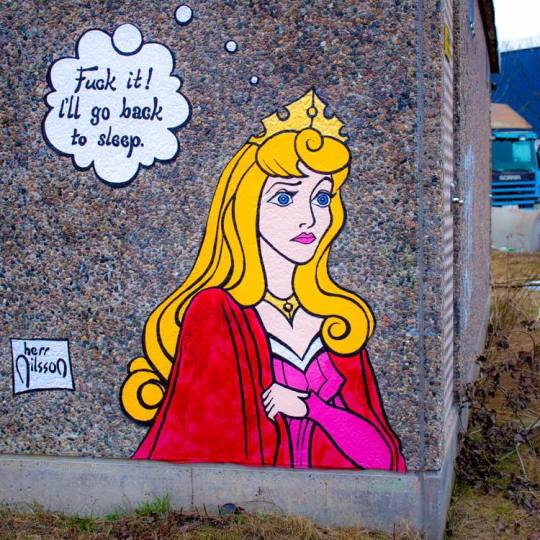
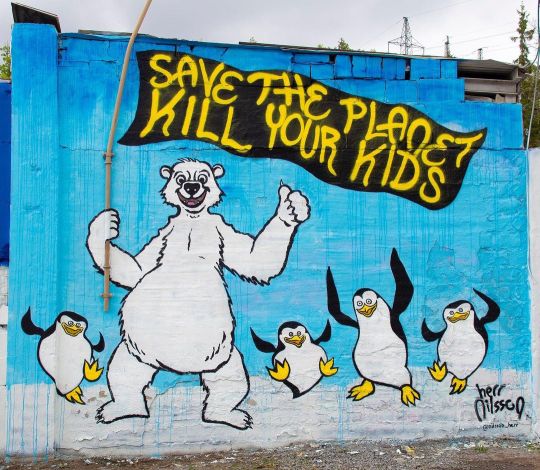

STREET ART, POP ART, CARTOON ART -- SCANDINAVIAN STYLE.
PIC(S) INFO: Spotlight on multiple street art pieces by Swedish street artist, Herr Nilsson. Featured pieces are as titled (and in no specific order):
"I drank all the booze and I feel Fantastic," in Stockholm, Sweden
"Hair Day" in Bromsten, Stockholm
"Save the Planet Kill your Kids (on climate change), in Snösätra, Stockholm
"Happy Riot," in Vällingby, Sweden
Sleeping Beauty piece in Lunda, Stockholm, Sweden, c. 2019
STREET ART UTOPIA: "How would you describe your working method?"
HERR NILSSON: "I’m almost constantly trying new ideas, sketching them in my mind until they are pretty much done, then I realize them in a painting or a sculpture. Most often I experiment with two strong symbolic things or characters that convey totally different messages. And then, when I put these two together in a painting or sculpture, the new meaning conveys something totally different. Something I would like to share with my audience."
Source: www.streetartutopia.com/2021/07/05/interview-with-swedish-street-artist-herr-nilsson.
#Herr Nilsson#The Simpsons#Street Art#Street Artist#Marge Simpson#Simpsons#Anarchism#Political Art#Smurfette#Winnie the Pooh#Piglet#Animation#Climate Disruption#Environmental Art#Polar Ice Caps#Disney Animation#Herr Nilsson Art#Socio-political Art#Urban Art#Pop Art#Scandinavia#Graffiti Art#Disney Art#Smurfs#Stockholm Sweden#Climate Change#Sweden#The Smurfs#Stockholm
12 notes
·
View notes
Text
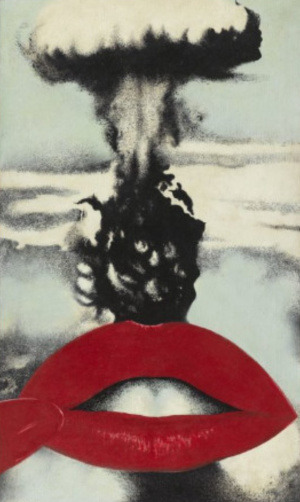
Atomic Kiss, Joan Rabascall, 1968
‘Atomic Kiss reflects the year 1968. It was the year of student protests from Berkeley to Berlin, via Paris. The refusal of the Vietnam War, the threat of a possible world war…’
"On the other hand, and in a more subtle reading, Rabascall reflects on the power of the media, alluding to the onslaught of invasive and massive images to which we are subjected."
#art#painting#joan rabascall#1960s#atomic kiss#spanish artists#superimposition#socio political messaging#media#collage
77 notes
·
View notes
Text
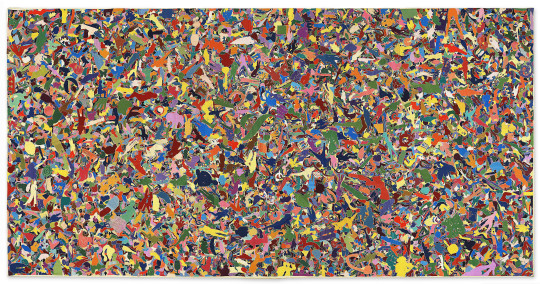
Alighiero Boetti, "Tutto" 1990,
Embroidery on Linen, 86 1/2 x 170 1/4 in. (219.7 x 432.4 cm.)
In the spring of 1971, while in search of “something distant”, Alighiero Boetti discovered Afghanistan. This was the beginning of a relationship that tied the man and his work to the Afghan people for 23 years until the artist’s death in 1994.
Boetti maintained these links during the period of exile following the Soviet invasion of 1979, even welcoming some of his assistants into his own family in Italy.
Afghanistan is the scene of the production of many of Alighiero Boetti’s best-known works, including the Mappe (1971-1994), made by female Afghan embroiderers.
His artistic intentions, his experience of the country and his intellectual curiosity give rise to works that act as cultural and geopolitical seismographs.
His work bears witness to the socio-political transformations that affected the Middle East in the 1970s and 1980s, seeing, for example, the embroiderers flee to Peshawar in Pakistan, where some of the last embroideries were produced.
#art#abstract#abstraction#forms#fabric#embrodery#alighiero boetti#all#tutto#tornabuoni art#salman ali#afghanistan#political#afghan#socio-political#middle east#peshawar
46 notes
·
View notes
Text



The New Order v.2 aka Golden age now comes with an extra sense of technological superiority or smth...
Of course, we can't forget the absurd laws being put in place to be bypassed!
#local politics is top tier comedy gold#me and my irl had a GREAT laugh while talking about it man😭#we eat government slandering for breakfast#political roasts for lunch#and historical socio-politics for girl dinner#my art#seirre sketchbook
1 note
·
View note
Text
reads a new webcomic, instantly translates designs into Tron helmets, more at 8

#so this is a really good comic. hdfjfjgkgk#james doodle#my art#nomads webcomic#red mask#green mask#blue mask#yellow mask#am i going to make an entire au on this and translate a socio-political structure into Tron that has nothing to do with it? maybe
21 notes
·
View notes
Text
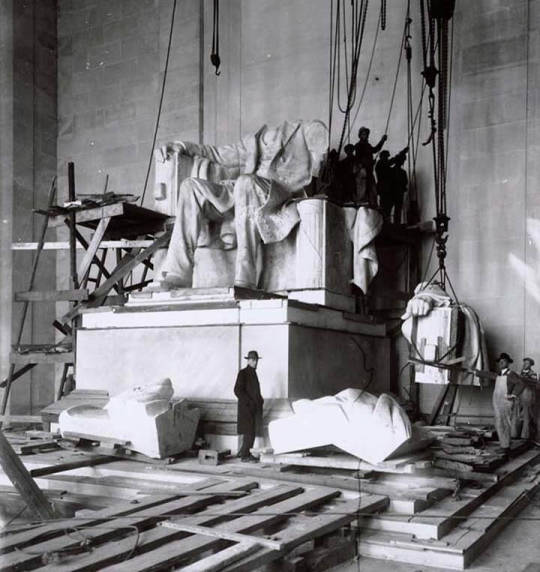





Photos showing the construction of the Lincoln Memorial (including the assembly of the statue), the subterranean space included in the structure, the "I have a dream" plaque (in honour of Martin Luther's speech at the site and five dollar bills showcasing the building.
#construction#engineering#architecture#art#sculptures#lincoln memorial#i have a dream#martin luther king jr#five dollar bill#socio-economic#socio-political
1 note
·
View note
Text
-> 𝚕𝚘𝚊𝚍𝚒𝚗𝚐 𝚌𝚊𝚜𝚎 𝚏𝚒𝚕𝚎...
-> 𝚌𝚊𝚜𝚎 𝚏𝚒𝚕𝚎 𝚕𝚘𝚊𝚍𝚎𝚍 𝚜𝚞𝚌𝚌𝚎𝚜𝚜𝚏𝚞𝚕𝚕𝚢!
-> 𝚘𝚙𝚎𝚗𝚒𝚗𝚐 𝚌𝚊𝚜𝚎 𝚏𝚒𝚕𝚎, 𝚙𝚕𝚎𝚊𝚜𝚎 𝚠𝚊𝚒𝚝....
-> 𝚌𝚊𝚜𝚎 𝚏𝚒𝚕𝚎 𝚜𝚞𝚌𝚌𝚎𝚜𝚜𝚏𝚞𝚕𝚕𝚢 𝚘𝚙𝚎𝚗𝚎𝚍! 𝚠𝚎𝚕𝚌𝚘𝚖𝚎 𝚝𝚘...
𝚘𝚙𝚎𝚛𝚊𝚝𝚒𝚘𝚗: 𝚋𝚛𝚘𝚠𝚗 𝚎𝚢𝚎𝚜 !


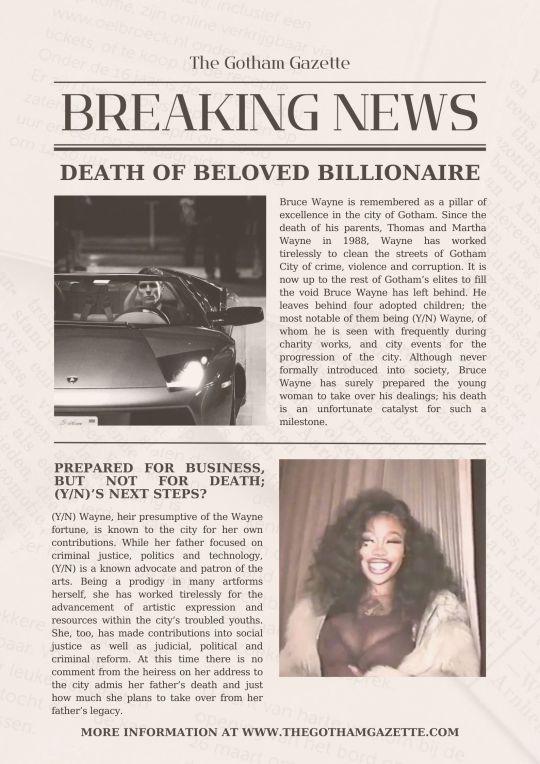

—> OVERVIEW
—> The death of Bruce Wayne has shaken the city of Gotham to its core. His presence defined the very city he vouched for for years, and while many mourned the death of one of the city’s highest elites, no pain could be compared to that of (y/n)’s, eldest daughter and heir to the Wayne Family. The beloved father-daughter duo were the saving grace of Gotham City; Bruce pouring his attention into politics, social and criminal justice and technology, and (y/n) strongly advocating for the arts, social change and socio-economical and political reform. With tragedy in the air and crime running amuck in the streets, what will become of the brilliant and beautiful (y/n) Wayne amidst the turmoil within her city, within her family, and within her own heart?

—> OBJECTIVES
—> (y/n) has not spoken since arriving at the Belfry. She spends her days reminiscing on the times when Bruce was alive, holding on to what little memories she has. Much of her memories are stored in the gifts Bruce had given her over the years, as well as moments the family has shared together. Your task is to retrieve these objects from across Gotham and unlock core memories of the heiress’s childhood with the Wayne family, in hopes to restoring (y/n) back to her original self.

CHOOSE YOUR ROUTE
MAIN STORYLINE
NIGHTWING | RED HOOD | ROBIN | BATGIRL

ADDITIONAL ROUTES UNLOCKED
ALFRED PENNYWORTH | BRUCE WAYNE

🇫🇮🇳🇩 🇹🇭🇪 🇮🇹🇪🇲🇸
🇷🇪🇱🇮🇻🇪 🇹🇭🇪 🇲🇪🇲🇴🇷🇮🇪🇸
🇪🇽🇵🇪🇷🇮🇪🇳🇨🇪 🇹🇭🇪 🇱🇮🇫🇪 🇴🇫
🇬🇴🇹🇭🇦🇲’🇸 🇩🇦🇷🇱🇮🇳🇬
🇨🇱🇮🇨🇰 🇾🇴🇺🇷 🇷🇴🇺🇹🇪 🇹🇴 🇵🇱🇦🇾
🇳🇴🇼

⚠️This Series Will Contain: canon-accurate violence with weapons such as guns, knives, batons, customized batman gear and other vigilante gear, hand to hand combat, mentions of blood, injuries, heavy talk about grief, depression, anxiety, major character death (bruce wayne/batman). Readers discretion is advised.

Tag List: @punkeropercyjackson @insomniac-jay @neesieiumz @honeypotsworld @honeybleed @hellkaiserinphoenix @saintriots @agent-nobody-knows @badass-dora-milaje @sincerelyzee @anuttellaa
#black reader#black tumblr#black dc#dc comics#dc games#dc batfam#dc bruce wayne#dc batman#dc nightwing#dc red hood#dc robin#dc batgirl#gotham knights#batman gotham knights#dick grayson x reader#dick grayson#jason todd x reader#jason todd#tim drake#tim drake x reader#barbara gordon#barbara gordon x reader#gotham knights bruce wayne#gotham knights batman#gotham knights dick grayson#gotham knights jason todd#gotham knights tim drake#gotham knights barbara gordon
216 notes
·
View notes
Text
So a few days ago I saw someone (elsewhere) questioning Zutara fans’ excitement about the scarf scene. It wasn't a mean comment, more general curiosity. And well, I didn't have time to get my thoughts out then. But they haven't gone away, so I'm getting them out here:
Here’s what everyone need to understand about Zutara shippers. We were baited baaaad during the initial run of the show–from the magazines to the shorts to the trailers and how they were cut. And Zuko and Katara’s relationship on the show certainly underwent a lot of development and featured objectively emotional–if not overtly romantic–moments between the two. We were well fed, and we had reason to hope. Right up to the end, we had reason to hope.
The shipping wars were the shipping wars, of course, with all the usual tensions; there are always going to be overzealous fans of each (and any) pairing willing to get toxic. Generally, I think Kataang fans were always jealous of Zutara’s popularity and Zutara fans, post finale, were jealous of Kataang’s, well, canon status. But really it operated much the same as any other large fandom’s shipping wars.
And then came Bryke and the panel where they showed and mocked Zutara fan art, some of which had been created by teens if not straight up children. Then came their, “Come on, kids! It was never going to work. Zutara is just dark and intriguing.”* And the pièce de résistance, their telling Zutara shippers (specifically girls/women) that they were doomed to have failed romantic relationships. Like, what? The thing with the art was arguably cruel, and the rest of it was oh, so condescending. Just all around not well done.
The after effect was that Zutara went from being simply a fanon pairing to a wrong pairing. The ATLA fandom at large became a far more hostile place for Zutara fans, who were now more commonly deemed delusional and viewed as lesser fans. The vitriol only got worse when the show came to Netfilx and the next wave of antis rolled up with their co-opting of legitimate socio-political terms to paint Zutara not just as wrong but morally corrupt if not evil. It’s all very puritanical.**
So Zutara fans need to be reminded that we weren’t delusional, and we aren’t alone. It’s why it means so much to know that Dante Basco and Mae Whitman shipped their characters. And that so many other VAs came out as Zutara supporters too: Jack De Sena, Michaela Jill Murphy, Grey DeLisle, Janet Varney--even the cabbage man. For it to be revealed that it was discussed in the writers room; that the writers fought over it; that it WAS a canon possibility. (And that writers Joshua Hamilton and John O’Bryan are perfectly comfortable admitting their preference for Zutara.) To know that the Elizabeth Welch Ehasz described Zuko and Katara as an “Avatar-style Mr. and Mrs. Smith,” in the script for The Southern Raiders, and used the phrase “Zutara-feuling synchronicity and cooperation” to describe their action sequences. To see Giancarlo Volpe, a Kataanger, admit Zutara might been the better pairing in retrospect and choose a quiet scene between them (to see their “chemistry”) as what he’d most look forward to in the live action adaptation. It’s why we cling to the artwork done by Korean animation director. We aren’t delusional. We aren’t alone.
But try telling that to the general fandom, right? Most are ignorant of a lot of this, particularly Hamilton and O’Bryan’s revelations re: the writers room. A lot of Zutara fans don't even seem to know. But being baited by Netflix on their official accounts? Oh, people see that. And we are reminded in a big way that we aren't delusional and we aren't alone. And everyone else has to remember it too.
So, of course, we're having fun clowning over the scarf scene. And I think most Zutara fans know we are clowning. I don't think most expect to get canon Zutara in live action because of one little scene or the fact that their Netflix icons are facing each other. (I headcanon that that was totally the doing of Zutara shipper on staff, though, lol. Because there are a lot of us, and we are everywhere.)
And this is okay. Zutara has been doing just fine as a fanon ship. Meanwhile, NATLA might actually do Kataang justice. It always worked better as a future ship. (Really all the pairings do. But I especially don't ever need to see another 12 year old kissing let alone making out, in animation or live action, ever again.) There's a reason Padme and Anakin don't get together in Phantom Menace, after all. Also, there's always the chance they could give us Dante's or Mae's headcanon of them basically suppressing their feelings and choosing duty over love/right person-wrong time. And the odds of getting some more moments to clown over are high enough.
Anyway, TLDR: Zutara has been made to feel like an out-of-nowhere crack ship and the live action crumbs remind us that it is not. And this is at least partially why we are enjoying it. (Because, also, it's just fun!)
*Side tangent: I’ve never gotten this dark and intriguing comment. Even during Season 1, the height of the capture fic era, Zutara was always a ship fundamentally about hope, predicated on Zuko's redemption. (Back in the day, there were also plenty of antis arguing that there was no way Zuko would ever be one of the gaang.) And they say “intriguing” like it’s a bad thing? Are we not supposed to be interested in the relationships of their characters???
**There have been some very good think pieces written lately on late stage capitalism and consumption as morality. Worth googling.
339 notes
·
View notes
Text
Creating fantasy religions: something I'm doing now so thought I would post about my process.
The mistake a lot of writers make is developing a religion from a singular event, and piling a ton of stuff on top of it that makes logical sense. Whereas, in reality, religions are self propelling systems that travel under their own steam and if there is an event that catalyses them, it is never in a socio-cultural or political and economic vacuum.
You also end up with an apparently totally random set of things attached to one figure which does make sense if you know the origins, but otherwise is just accepted even if the meaning is lost.
It is the difference between "the god of Midwinter and festivals around this originated because a cult of necromancers were banished into the frozen wastes and this <event> became the Origin Story for how we got to a midwinter festival with creepy bone puppets in my fantasy world" and a religion that feels ... Real.
Ok so firstly, this is a bit too neat. (This was my original reasoning for a midwinter god called Yarash and I changed it because it wasn't very realistic or interesting for my world.)
Why, let's say, is the god whose feast is at midwinter also the patron of puppet makers and osteopaths?
Well, we could say that this makes a lot of sense because the god's festival was originally to do with remembering the dead, and puppets were used in the festival to represent the dead, as necromancy should have been part of it but people didn't actually know how to raise the dead properly. Then as magic evolved people could actually raise the dead for short periods to deliver messages in these festivals, but this drew internal debate from the conservative priests who thought puppets were the original form and so should be maintained, and necromancy was an aberration, vs the progressives who saw necromancy as the original INTENTION and so the natural and correct progression from the puppets. The debate might rage on for years creating splinters, sects, differing traditions that sit uneasily together but find middle ground in other less controversial topics and practices, and even cults.
At some point, the secular authorities get involved for their own reasons. Maybe some rulers are pro-"The Old Bones" or anti-, or they want to outlaw necromancy or benefit from it for various political reasons, socio-cultural reasons, economic reasons, military intelligence reasons, etc. Whatever happens, happens. Times change. Official attitudes swing back and forth, while internally the religious debates continue, now informed by and perhaps as counters to, this secular intervention.
Then we end up in modern times, the times of the story. Nobody really believes in gods anymore. They do remember the old gods of the seasons and at the secular festival in winter, there are a lot of traditional puppet shows that have a whole history and life of their own. The puppets are called "the old bones" and nobody really remembers why. Osteopaths have the puppets and symbols relating to the midwinter festival on their certificates and college heraldry and nobody really remembers why, but the information is there to look up and is a fun thing to know for trivia nights.
And necromancy... is a controversial branch of science, divorced from its original religious significance for many but not for all, and more integrated as an art or practice in the public consciousness (positively or negatively depending on perspective and propaganda and actual usage).
And now, you have a ton of depth and meat to it without having to flesh out the arguments and debates themselves unless that is plot relevant.
There is a lot you can do with this society now, and by tweaking one thing you can create completely different societies and ideologies. The depth is now there to set your story at any point during this history and to develop numerous ideas. So much stuff can happen.
With the singular event version, and a static fact of a necromancy cult in the frozen wastes, things are much more limited and linear, with less depth to play with.
Also remember that your characters will not be expected to know everything about your world unless they are experts in religion and/or history, and also the 2 subjects are not mutually inclusive so a historian is not an expert theologian and vice versa. How much the average person on the street knows depends on levels of formal education, accessible knowledge beyond formal education, which may include religious instruction and folklore, and propaganda. But it means you can build in some subtle things - like the puppet symbols on the door of an osteopath or bone doctor - that never need to be explained, but have a logical in-world explanation below the surface.
Try taking a static idea and work it into a system and see where it leads!
EDIT: I'm doing a workshop on Build A Hellscape at the Devils and Justified Sinners online conference, Saturday 24th Aug 2024, 9AM UK Time. Sign up below:
#writeblr#worldbuilding#fantasy religion#writers on tumblr#writing community#writing tips#world building#writing fantasy#fantasy#fantasy writing
357 notes
·
View notes
Text
sculptures* round 1 poll 15


tap to view full images
Agora by Magdalena Abakanowicz, 2006:
propaganda: With their size and their headless bodies they have something eerie, the artist once described crowds as a "brainless organisms acting on command, worshiping on command and hating on command" (Alan G. Artner (16 November 2006). "Provocative achievement in Grant Park". Chicago Tribune)
the installation is currently exhibited in chicago
The legality of space by Ewa Partum, 1971:
propaganda: this installation at freedom square in łódź was showing the absurdity of socio-political existence in the 1970s poland. the signs read, for example: "it's forbidden to forbide things", "everything is illegal", "it is prohibited to cultivate anything", "consumption not allowed"
propaganda: A thing that for me comes up again and again with performance art is the idea of taking up space as a comment of power - the many signs here are clear representations of power. The pairing with the name of the setting (freedom square) bring a dark humor to it.
about the artist: Ewa is seen as one of the first generation of polish conceptual artists.
55 notes
·
View notes
Text


AH, THE FAMED SWANSEA, WALES GIG -- THE MOST PHOTOGRAPHED CRASS GIG EVER?
PIC(S) INFO: Spotlight on two photographs reportedly purchased on eBay of English anarcho punk bands CRASS and D.I.R.T., performing live at St. Phillips Community Centre, Swansea, Wales, UK, on September 24, 1981. The photos were eventually used as part of "The Art of Crass," an exhibition in Leicester, England, in June 2016.
Source: www.flickr.com/photos/seancuttlefish/25362133763 (Flickr 2x).
#CRASS#CRASS band#CRASS 1981#1981#Anarcho punk#UK punk#D.I.R.T.#80s#Object Refuse Reject Abuse#Punk gigs#Punk photography#D.I.R.T.. band#1980s#80s punk#Anarcho#Socio-political punk#N.A. Palmer#Phil Free#Penny Rimbaud#Steve Ignorant#Wales#Swansea Wales#Swansea UK#Pete Wrong#Art Collective#Photography#Second Wave UK punk#Art punk#Punk is Dead#Wales UK
18 notes
·
View notes
Text

Solstice ☀️ Sol ☀️ Sunny
he/him ⭐ they/them ⭐ she/her
28 years old ; tme two-spirit first nations wo/man
@mermen is my moonlight 🌙

★ minors do not follow or interact thank you
☆ white supremacists, transmisogynists, sex bioessentiallists, TERFs, and anyone who follow these kinds of beliefs will be blocked
★ if you notice i've interacted with anyone who follows the above ideology or they have interacted with me, please let me know! i might have not noticed
☆ feel free to dm me any donation posts or anything else you need boosted. i will do my best to boost it during the day.
★ i always read abouts, carrds, rentrys, & pinned posts! i might forget to like posts after, or might unlike them after some time to keep my likes clean
☆ i try to keep others' blacklists in mind but if i forgot to tag something, feel free to send me an ask or a message! i will do my best to remember but the dissociation might fuck with me so if it's something important but niche you need tagged, i might need multiple reminders so just unfollow if you're worried about it...
★ disabled, neurodivergent polyfrag system
☆ remade on july 18th 2024
art blog: @solsunbeam
more about under the cut! ^^ not necessary to read

☀ my socio-political beliefs: land back, pro palestine, anti-colonization, harm reductionist, anti-canada and anti-usa, anti capitalism, defund & dismantle the police, prison abolitionist, anti child family services, pro family reunification, better funding for social services, pro universal healthcare (including mental health resources, optometry, AND dentistry), antipsychiatry, pro universal basic income, decriminalize drugs, sex bioessentialism is rooted in white supremacy, and may all the catholic churches burn down thank you
☼ i don't 'debate' any of the above with anon asks. if you want more info on why i hold these beliefs, you can ask me privately via message. though, i may block you if your vibes are bad. if you deeply disagree with the above, then i rather you block me than try to convince me otherwise. i'll save us both the time and just block you.
☀ in general i block whenever i feel i need to
☼ i occasionally post about the above, but this blog will also contain a mish-mash of my interests, personal posts, fashion pictures, nature pics, and like.... idk whatever ✌🏽
☀ mutuals this is your sign to ASK FOR MY DISCORD! come. enter my dms. let me send you pictures of my cats.
☼ interests: poetry, art, films, fashion, video games, animation, plants, comics, child welfare, trauma recovery, disability rights, tarot, witchcraft, the occult, linguistics, lolita fashion, and all kinds of other stuff
☀ video games: kingdom hearts, fire emblem, legend of zelda, animal crossing, final fantasy, supergiant's hades, minecraft, mario bros, pokemon (mostly gens 1-5), sonic the hedgehog, undertale, deltarune, // anime/manga: witch hat atelier, dungeon meshi, sailor moon, revolutionary girl utena, yugioh duel monsters, card captor sakura, madoka magica, hunter x hunter, ghibli movies, and other stuff lol
☼ alters may or might not tag their posts as [alter name].txt feel free to refer to them as their name! but we all respond to the collective name as well <3
☀ my final message...... peas and lov on planet erth....... goodnight

94 notes
·
View notes
Text
Bigots and Failed Promises of Mass Effect games
(I had this thing in my drafts for almost a month, and it would have stayed there if not for the wonderful post by @androidtrashfire, because I saw it, and I was like: "Fuck it, I have to rant about these games."
I love Mass Effect, and I really think we should critique it. We should criticize things we love because silence = compliance.)
So I was talking to @liss-art recently about the bigoted fans in the Mass Effect fandom, and I think I need to make a post about it because it's something that really, truly bothers me, and it needs to be addressed.
Canon
Mass Effect is a story about deeply flawed people with a lot of problems, and through them it touches on issues like xenophobia, sexism, corruption, elitism, morality, identity. That's why we like it, right? But why are there so many bigots in the fandom? My theory is that it happens because Mass Effect, for all its supposed complexity, only touches on these issues without giving any meaningful commentary on them.
Here are a few obvious examples:
The Quarians are a distasteful allegory of the Roma people (right down to their accents). They are persecuted and ostracized for creating Geth, but the game never gives us any socio-political reasons why the Quarians did that. They just developed real AI because they were naive and stupid? Or because they were the only ones smart enough to do it? Did they do it in secret? Why did other races not make the same mistake?
Same with the Batarians. Yes, the game mentions tensions between humans and Batarians because humans try to claim territories that Batarians think are theirs, but that's about it. Batarians are all racist slave traders and they're bad, don't think about it, here's some memes about 300,000 of them dying, good job. And yes, I know you can read more about their history in the Codex (why is it an Asari who writes about Batarian history,btw?), but it's basically the same thing as saying D*mbledore is gay (I really am sorry for this reference). If no one ever mentions this rich Batarian history, then it doesn't exist.
And please don't get me started on Hanar. They "mercifully" saved the Drell by inviting them to their planet, immediately assimilated them into their own faith and also put them in conditions where they have to train as assassins from the ripe old age of 6 and eventually die of sci-fi lung cancer. But don't worry about it, Drell actually love to serve the Hanar, they do it willingly and consider their servitude an honor. Do you really want to criticize some stupid jellyfish who talk funny? Do you really want to talk about why the so-called Council races do nothing about it? LOL
Another thing the trilogy does is present entire races, including humans, as amorphous blobs. Do all Asari believe in the same "goddess"? Do all Turians obey the same Primarch? Well, what's important is that all humans in this bright future speak English.
But what about the genophage? That's a profound story, right? Well, not really, and it raises more questions than it answers. We hear a lot about how brutal, aggressive, and short-tempered Krogans are, but every single Krogan we meet is extremely well-mannered, and they only resort to violence against other races in dire circumstances. So why not save them? Does the game really present you with this moral dilemma or not?
And can anyone tell me why Salarians are allowed to abduct and experiment on sentient beings, and why Turians are allowed to wage wars? Why does no one talk about Asari in this context?
I really want to say that at least the characters are well written, but I can't because they're not.
Kaidan is a good example of this. We are told about his implant, we are told that he has chronic pain, but do we see him suffer from it? Do we see him in those moments of weakness and vulnerability?
The scene where he gets annoyed with Jenkins acting like he's a circus monkey who has to do a trick and biotically throws a cup at him was cut from the game. We occasionally hear him mention some of the side effects of his migraines ("Too many lights, too much noise"), but that's about it. What has happened to "show, don't tell"? And no, I'm not saying that the writers should feed me the story or walk me through it. What I am saying is that if you gloss over your characters' mistakes, flaws, and circumstances, you're getting people to ignore them. Do people who call Kaidan "boring" and insult him think about how his chronic pain, his trauma from Brain Camp, and the loss of Jenkins and Ashley affect who he is? Hell no.
Thane is another great example. What Mass Effect is telling us as a story is that you can completely abandon your family and your child and be forgiven if your reason for doing it is good and heroic enough. Like avenging your dead wife, because of course there has to be a dead woman thrown somewhere.
Everyone's favorite Garrus (mine too) is a cop whose character arc basically consists of deciding that he is above the law (since the law forbids him from killing people he thinks should die) and then involving his squadmate/friend/partner (depending on your playthrough) in the public assassination of his former squadmate, whom he never even bothered to confront first. Are there any consequences for Garrus for his actions? No. Again, it's all glossed over, and that's unfortunate because it removes the conflict and therefore the character development and depth.
And if you're going to tell me that ME is just a space opera, and that I should just enjoy the spectacle and the romance, then I'm going to tell you that I know that, and that I think it's a wonderful spectacle, and that some of the romance subplots are absolutely amazing story-wise, but the superficial commentary (or lack thereof) on the most important issues that ME covers actually harms the audience.
Fandom
On the one hand, we have people making mods that remove all the clothes from all the female characters (or remove all of femShep's organs and replace them with giant tits). We have people reposting that horrible, horrible art of Miranda and Jack fighting, tearing each other's hair and clothes, and maleShep smirking and saying "I should stay". We have people who say ME2 is the best game in the series because "there are no f*gs".
On the other hand, we have people saying things like "there are two Commander Shepards - female and the wrong one". We have people who say "only weird people play as dudebro in 2024". We have people who think that simply playing as a female character is some kind of feminist statement, and that it makes them better and smarter than everyone else (the same people who use the term "dude gamer" as an insult).
And all of those things are kind of the trilogy's fault.
Both maleShep and femShep have the same story. The only differences are the romance options, sexist remarks directed only at femShep, and flirtations from various NPCs directed only at femShep. What this tells you is that sexism exists in the Mass Effect universe, and only women suffer from it. It also tells you that only women are worth flirting with.
Another thing this game does (and modern games like Cyberpunk do the same thing) is equate the female experience to the male experience by giving both femShep and maleShep the same lines.
So there are some mixed signals here. Sexism exists and doesn't exist in this universe, Shepard is both genderless and very gendered, romances with underdeveloped characters are all over the place, and bigots thrive in this kind of environment.
The lack of commentary, the lack of perspective, the disastrous worldbuilding allows you to freely choose your sexist, racist adventure and not be punished by the story in any way.
Mirrors
There's a passage from Solaris that I absolutely adore and think about often.
"We don't want to conquer the cosmos, we simply want to extend the boundaries of Earth to the frontiers of the cosmos. […] We have no need of other worlds. We need mirrors. We don't know what to do with other worlds. A single world, our own, suffices us; but we can't accept it for what it is."
I think that perfectly describes what Mass Effect is as a universe. And in a way, it's a reason why it's so compelling. It's just empty enough for us to invest in it, to fill in the blanks of that narrative with the stories of our own. And it's also a reason why this fandom is a fucking hellscape.
#mass effect#my thoughts#kaidan alenko#thane krios#garrus vakarian#commander shepard#sorry not sorry for the wall of text because this is important#my stuff
55 notes
·
View notes
Text

In the heart of the ancient Achaemenid Empire, a masterpiece of Persian artistry emerges—a rhyton (drinking horn or in the shape of a horn) carved from the deep blue lapis lazuli and adorned with gold, taking the form of a majestic ibex (mountain goat).
Dating back to the 6th to 5th century BCE, this exquisite ceremonial vessel not only exemplifies the sophisticated craftsmanship and rich symbolism of the time but also provides a fascinating glimpse into the cultural and economic prowess of ancient Persia.
[Description and Material]:
*Material:
Lapis lazuli, a semi-precious stone prized for its deep blue color, was highly valued in ancient Persia and sourced primarily from what is now Afghanistan.
*Form:
The rhyton is shaped like an ibex, a type of wild goat with prominent, curved horns, reflecting the importance of nature and animal motifs in Persian art.
[Use]:
*Function:
A rhyton is a type of vessel typically used for drinking or pouring liquids, especially in ceremonial contexts. The liquid would be poured from the top and flow out through the spout, which could be the mouth of the animal in this case.
*Ceremonial Role:
Rhytons were often used in religious and royal ceremonies. The choice of lapis lazuli and the intricate craftsmanship suggest that this particular rhyton was likely used by the elite, possibly in rituals associated with the Zoroastrian religion or royal banquets.
[Cultural and Historical Significance]:
*Art and Symbolism: The ibex design reflects the importance of wildlife in Persian culture and the symbolic use of animals in conveying power and divinity. The ibex, with its strong and agile form, could symbolize qualities such as strength and resilience.
*Trade and Wealth: The use of lapis lazuli indicates extensive trade networks and the wealth of the Achaemenid Empire, as this material was not locally sourced and had to be imported.
*Royal Patronage: The Achaemenid rulers were great patrons of the arts, and such luxurious items underscore their desire to display their wealth, power, and cultural sophistication.
[Academic Perspective on Material Culture]:
*Cultural Synthesis:
Scholars often view Achaemenid art, including rhytons, as a synthesis of various cultural influences, including Mesopotamian, Egyptian, and Greek, reflecting the diverse and cosmopolitan nature of the empire.
*Representation of Power:
Academics see these artifacts as representations of royal propaganda, showcasing the divine right and grandeur of the Persian kings.
*Symbol of Status:
In material culture studies, such high-quality items are considered symbols of social status and wealth. They provide insights into the social hierarchy and economic conditions of the time.
*Artistic Techniques:
The craftsmanship of the rhyton is analyzed for its artistic techniques, such as carving and polishing lapis lazuli, which indicate advanced skills and aesthetic values.
[Notable Examples]:
Museums and Collections: Notable examples of such rhytons can be found in major museum collections, such as the British Museum and the Louvre, where they are studied and displayed as prime examples of Achaemenid artistry and craftsmanship.
In conclusion, the lapis lazuli rhyton in the shape of an ibex from the Achaemenid period is a significant artifact that illustrates the artistic, cultural, and economic aspects of ancient Persia. It serves as a key piece of material culture, providing valuable insights into the ceremonial practices, trade networks, and socio-political dynamics of the Achaemenid Empire.
#ancient Persia#Zoroastrianism#ceremonial vessel#rhyton#lapis lazuli#Iran#Mesopotamia#Ancient history#Near East#ancient civilisations#ancient art#ancient craft#archaeology#Achaemenid#Achaemenid Culture
47 notes
·
View notes
Text
Palestine Readings And Resources
The following is a list of resources that includes books, articles, websites, and nonprofits to help you get educated and/or involved in action pertaining to the Palestinian genocide. I originally compiled this list for personal purposes, to use in my own local communities. Since it's been an unbelievably grim and never-ending shit-show on the blog for the past 5 weeks, I now feel compelled to make this list public on here in the hopes that it might benefit someone.
Please be aware:
This post is NOT an invitation for you to treat me as your token Palestinian friend, personal educator, or woke police taskforce. Grow your own moral spine.
This list was originally compiled shortly after October 7. It has, as of the writing of this post, been 163 days. A LOT has happened since. Therefore, this list is not exhaustive.
New ways to get educated and involve have since materialized, and, indeed, new ones materialize everyday. Do your own due diligence and decide what shape your engagement is going to take.
I am using my own specific expertise and skill sets as a scholar and educator of Literature and Philosophy to populate this list. Therefore, naturally, a lot of what you will find on here is geared towards educating and raising awareness about the historical, socio-political, philosophical and cultural underpinnings of this genocide and how its reflected in art.
If you are looking for more practical resources, find activist spaces in your local communities.
This List Contains
Non-fiction books about Palestine
Fiction novels by palestinian authors
educational web resources
Documentary
organizations to donate to
BOOKS
A. non-fiction
Edward Said, The Question of Palestine (written by a Palestinian-American literary critic and critical theorist)
Rashid Khalidi, The Hundred Years’ War On Palestine (written by a a Palestinian scholar and historian)
A Land With A People: Palestinians and Jews Confront Zionism (anthology)
Ghassan Kanafani, On Zionist Literature (written by a Palestinian novelist and political activist)
Noura Erakat, Justice For Some: Law and the question of Palestine (written by a Palestinian-American activist and legal scholar)
B. Fiction and Poetry
Susan Abulhawa, Against The Loveless World
Etaf Rum, Evil Eye
Mahmood Darwish, A River Dies Of Thirst
Adania Shibli, Minor Detail
WEB RESOURCES
Al-Shabaka: The Palestinian Policy Network
BuildPalestine
If you are a teacher looking to educate about Palestine,
DOCUMENTARY
Gaza’s Fight For Freedom (2019) Directed By Abby Martin
ORGANIZATIONS TO DONATE TO
The Middle East Children’s Alliance (MECA)
The Palestinian American Medical Association
Medical Aid for Palestinians
Jewish Orgs (specifically helpful for anti-zionist jewish conversations and advocacy)
Jewish Voice For Peace:
We envision a world where all people — from the U.S. to Palestine — live in freedom, justice, equality, and dignity.Like generations of Jewish leftists before us, we fight for the liberation of all people. We believe that through organizing, we can and will dismantle the institutions and structures that sustain injustice and grow something new, joyful, beautiful, and life-sustaining in their place...more here.
2. Jews For Justice For Palestine. Click here.
62 notes
·
View notes
Text
Ivan and Phoebe by Oksana Lutsyshyna
Ivan and Phoebe is a novel about a revolution of consciousness triggered by very different events, both global and personal. This is a book about the choices we make, even if we decide to just go with the flow of life. It is about cruelty, guilt, love, passion – about many things, and most importantly, about Ukraine of the recent past, despite or because of which it has become what it is today.
The story told in Oksana Lutsyshyna’s novel Ivan and Phoebe is set during a critical period – the 1990s. In the three decades that have passed since gaining independence, Ukraine has experienced many socio-political, economic, and cultural changes that have yet to be fully expressed. The Revolution of Dignity in 2014 marked a pivotal moment in the country’s history, as it signaled a shift towards European integration and a strong desire to distance itself from Moscow. Prior to this, Ukrainian culture had remained overshadowed by Russian influence, struggled to compete for an audience and was consequently constrained in exploring vital issues.
77 days of February. Living and dying in Ukraine
"77 Days," is a compelling anthology by contributors to Reporters, a Ukrainian platform for longform journalism. The book, published in English as both an e-book and an audiobook by Scribe Originals.
"77 Days'' offers a tapestry of styles and experiences from over a dozen contributors, making it a complex work to define. It includes narratives about those who stayed put as the Russians advanced, and the horror they encountered, like Zoya Kramchenko’s defiant "Kherson is Ukraine," Vira Kuryko’s somber "Ten Days in Chernihiv," and Inna Adruh’s wry "I Can’t Leave – I’ve Got Twenty Cats." The collection also explores the ordeal of fleeing, as in Kateryna Babkina’s stark "Surviving Teleportation '' and "There Were Four People There. Only the Mother Survived."
It also highlights tales of Ukrainians who created safe havens amidst the turmoil, such as Olga Omelyanchuk’s "Hippo and the Team," about zookeepers safeguarding animals in an occupied private zoo near Kyiv, and one of Paplauskaite’s three pieces, "Les Kurbas Theater Military Hostel," depicting an historic Lviv theater turned shelter for the displaced, including the writer/editor herself.
In the Eye of the Storm. Modernism in Ukraine 1900’s – 1930’s
This book was inspired by the exhibition of the same name that took place in Madrid, at the Museo Nacional Thyssen-Bornemisza, and is currently at the Museum Ludwig, located in Cologne, Germany.
Rather than being a traditional catalogue, the publishers and authors took a more ambitious approach. Rather than merely publishing several texts and works from the exhibition, they choose to showcase the history of the Ukrainian avant-garde in its entirety – from the first avant-garde exhibition in Kyiv to the eventual destruction of works and their relegation to the "special funds" of museums, where they were hidden from public view.
These texts explain Ukrainian context to those who may have just learned about the distinction between Ukrainian and Russian art. Those "similarities" are also a product of colonization. It was achieved not only through the physical elimination of artists or Russification – artists were also often forced to emigrate abroad for political or personal reasons. Under the totalitarian regime, discussing or remembering these artists was forbidden. Archives and cultural property were also destroyed or taken to Russia.
"The Yellow Butterfly" by Oleksandr Shatokhin
"The Yellow Butterfly" is poised to become another prominent Ukrainian book on the themes of war and hope. It has been listed among the top 100 best picture books of 2023, according to the international art platform dPICTUS.
The book was crafted amidst the ongoing invasion. Oleksandr and his family witnessed columns of occupiers, destroyed buildings, and charred civilian cars. Shatokhin describes the book’s creation as a form of therapy, a way to cope with the horrors. "During this time my vision became clearer about what I wanted to create – a silent book about hope, victory, the transition from darkness to light, something symbolic," he explains.
Although "The Yellow Butterfly" is a wordless book, today its message resonates with readers across the globe.
A Crash Course in Molotov Cocktails by Halyna Kruk
A Crash Course in Molotov Cocktails is a bilingual poetry book (Ukrainian and English) about war, written between 2013 and 2022, based on Halyna’s experience as an author, volunteer, wife of a military man and witness to conflict.
The Ukrainian-speaking audience is well-acquainted with Halyna Kruk – a poet, prose author and literature historian. Kruk is increasingly active on the international stage, with her poetry featured in numerous anthologies across various languages, including Italian, French, Swedish, Norwegian, Portuguese, Spanish, Polish, English, German, Lithuanian, Georgian and Vietnamese.
For an English-speaking audience, her poetry unveils a realm of intense and delicate experiences, both in the midst of disaster and in the anticipation of it. The poems are succinct, direct, and highly specific, often depicting real-life events and individuals engaged in combat, mourning, and upholding their right to freedom.
133 notes
·
View notes